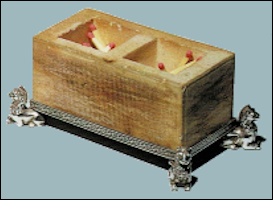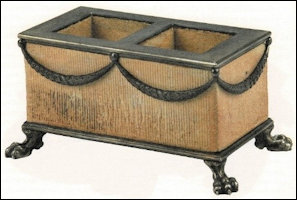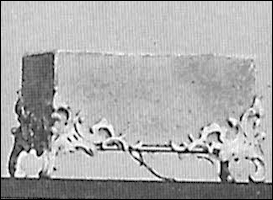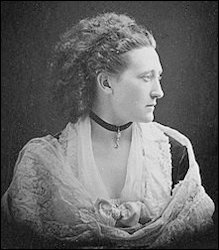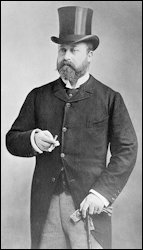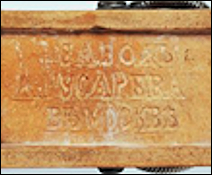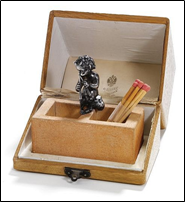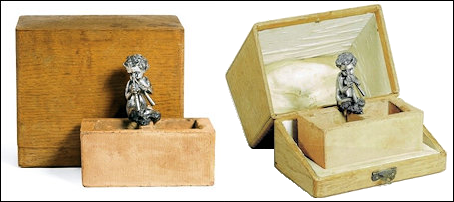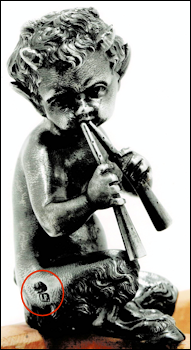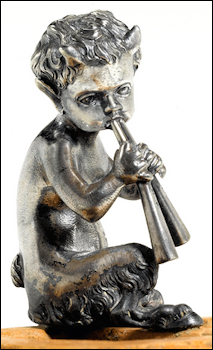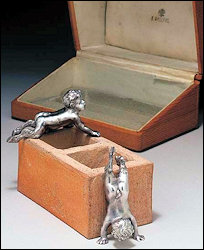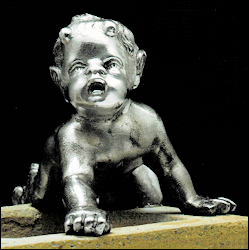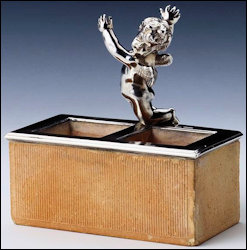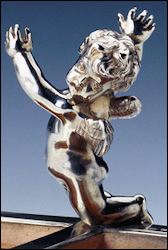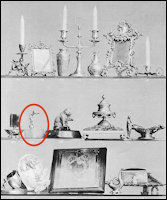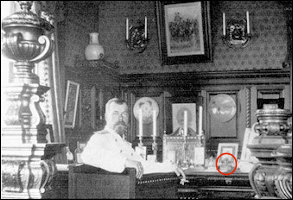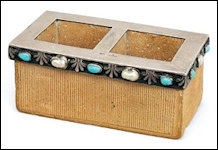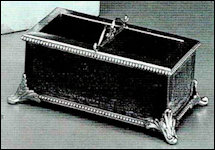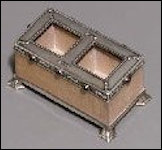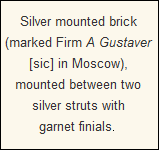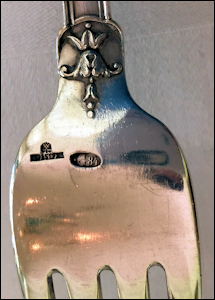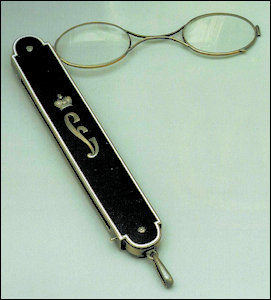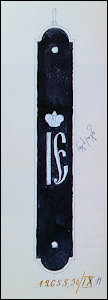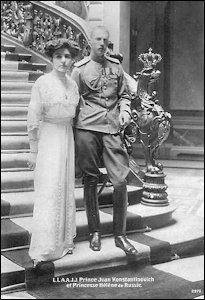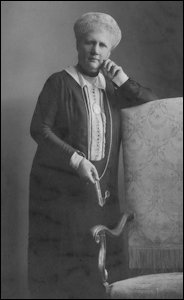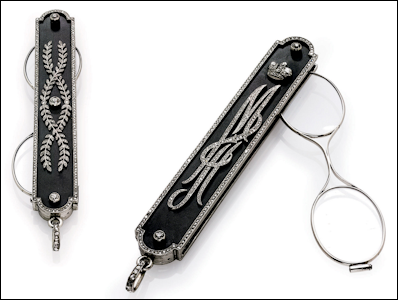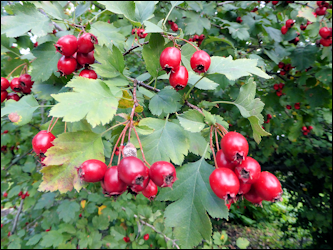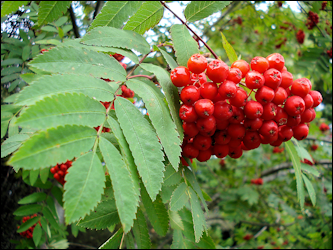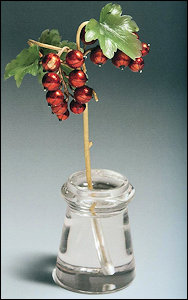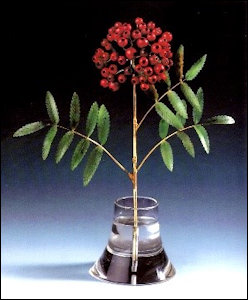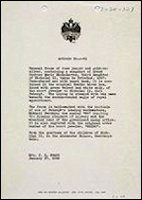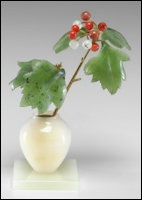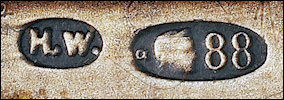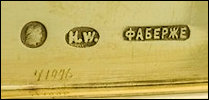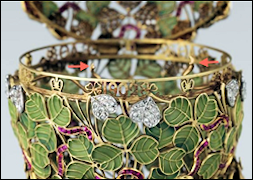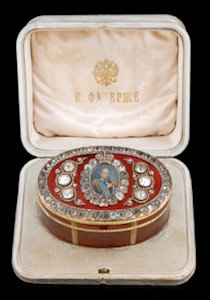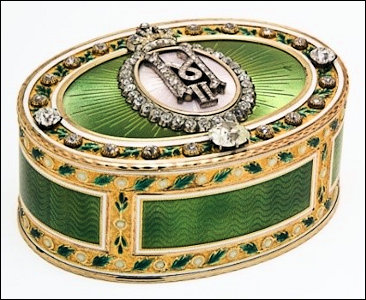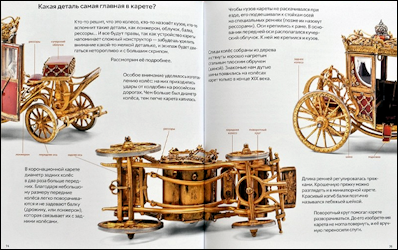Ten Fabergé “hawthorn” sprigs made of hardstone materials have appeared on the auction market in the last 44 years. Most of them are marked Fabergé, H.W.
(for Henrik Wigström), St. Petersburg ca. 1900. Wigström was appointed Fabergé’s head workmaster in 1903, a post he held until the Fabergé firm closed for business in 1918. My detective study began with a hawthorn flower sprig in an agate vase, estimated to bring €80,000 to €120,000 (US$ 94,500 to 141,500) at a 2018 auction. It did not sell. As a researcher and not an appraiser or auctioneer, I have not handled any of these sprays and therefore only worked with auction catalogs and books using lot descriptions, illustrations, and auction results, when available.
I was curious to determine-if I had the funds to invest-which hawthorn hardstone by Fabergé I would bid on. One immediate issue I faced was that not all hawthorn illustrations are identified correctly in the auction lot or book descriptions. Questions I tried to answer:
Comparing the Fabergé creations to the plants as they grow in nature, I discovered auction catalog descriptions contained some confusion about what a hawthorn bush (a thorny shrub) looks like, as compared to a rowan tree (also known as a mountain ash), or a red currant bush. The descriptions of the minerals used for the vases included jade, agate, chalcedony, and more.
 Hawthorn
Hawthorn
(Keefe, John Webster, Masterworks
of Fabergé: The Matilda Geddings
Gray Foundation Collection,
2008, pp. 72-73)
Red Currant & Rowan Tree
(Swezey, et al., Fabergé Flowers, 2004, 26 and 88)
All objects (in vases) above are attributed to Fabergé, only hawthorn in the Gray Collection is marked Henrik Wigström.
Géza von Habsburg after studying the hawthorn and archival records in the Pratt Collection of the Virginia Museum of Fine Arts, writes:
“Several versions of this plant exist, all very similar if not identical.” He cites the original Armand Hammer provenance in 1939 with cost of $1,450 from “the collection of a member of the Imperial family” for these flowers studying the Pratt collection and mentions an identical plant in the [Matilda Geddings] Gray Collection. He concludes, “This leads one to think that at best these hawthorns were replicated a number of times by Fabergé and that perhaps the forged hallmarks were added later.” Are the hawthorn objects in the Pratt and Gray collections originals from the Wigström shop or Fauxbergé?
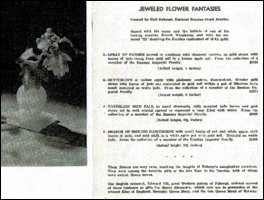 CLICK THE ABOVE PICTURE FOR A LARGER VIEW
CLICK THE ABOVE PICTURE FOR A LARGER VIEW
English Hawthorn with Nephrite Leaves, Agate
Vase and Pedestal, Gold Soil with Seven (7) Red
Berries and Three (3) White Berries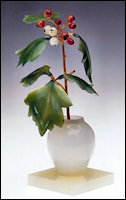 Gray Collection
Gray Collection
(Keefe, John Webster,
Masterworks of Fabergé:
The Matilda Geddings
Gray Foundation
Collection, 2008,
pp. 72-73)
Answer to Question #2 – Auction Results:
Did the object have a fitted and possibly marked case? The first time a case was shown in an auction catalog occurred a year ago, (Dorotheum, Vienna, May 29, 2018, Lot 346).
Between 1975 and 2001, out of seven hardstone “hawthorn” objects that came up for auction, three sold and four did not. For the years 2007 to 2018, three hawthorns were on the market, and one sold for €285,000, one was withdrawn before the auction, and one did not sell.
The same hardstone hawthorn sold successfully three times, in 1975, 1981, and 1985. Matching provenances and photographs helped to identify identical hawthorns with the 8:2 ratio of red berries and white ones. Archival records including details from the 1935 Fabergé exhibition catalog and an illustration from the 1979 book by the renowned A. Kenneth Snowman, proprietor of Wartski London, yield the data below:
Provenance: Miss Yzanga (sister of the Duchess of Westminster)
Exhibition of Russian Art, 1 Belgrave Square, London, 1935 (Ed. note: Exhibition of Russian Art catalog, page 110, states object 588 K “Bunch of Rowan Berries, in pourpourine [sic], with jar of white jade”, not illustrated. Rowan berries are not hawthorns as illustrated above)
Later Provenance: Madame Josiane Woolf, France
Spray of Hawthorn Planted in a White Chalcedony Vase and Base, Height 5 5/16 inches.
Gold Mark 72, Signed H.W. for Henrik Wigström
(Snowman, A. Kenneth. Carl Fabergé, Goldsmith to the Imperial Court of Russia, 1979, 85)
Specifics of the three sales of the same object follow:
- Christie’s Geneva, November 11, 1975, Lot 263, rowan berry (more correctly hawthorn), fitted case, formerly owned by Mlle. Yznaga del Valle, sister of the Duchess of Manchester, estimate SFr 50,000-60,000, sold for SFr 32,000.
- Christie’s Geneva, May 12, 1981, Lot 114, offered from Josiane Woolf Collection as a mountain ash (more correctly hawthorn), with fitted original holly wood case, and acquired through A.K. Snowman, final bid SFr 190,000.
- Sotheby’s New York, December 11-12, 1985, Lot 117, spray of hawthorn with the provenance of Mlle. Yznaga del Valle and Josiane Woolf, in an original fitted holly wood case. Sold for US $110,000.
At this point in my study I realized six hawthorns on the auction market each bore seven (7) red berries and three (3) white berries, i.e., the 7:3 ratio, two with the 8:2 ratio, and the last one with a 6:4 ratio which had piqued my interest. They were made of purpurine, aventurine quartz, and chalcedony. Two of the studies were in glass/rock crystal containers, four sprigs were presented in white vases, plus the hawthorn (illustrated on the right below) in a fitted case. Only one had sold for FFr 4,500 in 1975 (ca. $21,000 in 2019).
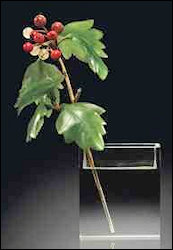 Hawthorn Sprig in Rock
Hawthorn Sprig in Rock
Crystal Vase, (7:3 ratio)
(Christie’s London,
November 25, 2013, Lot 233)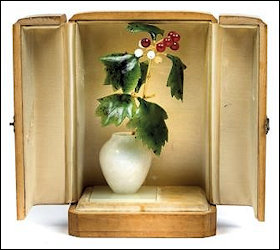 Hawthorn Sprig in White Vase and Diptych Case
Hawthorn Sprig in White Vase and Diptych Case
(6:4 ratio)
(Dorotheum, Vienna, May 29, 2018, Lot 346)
Two auctions for sprigs in rock crystal vases (none sold):
- Sotheby’s Geneva, May 11, 1983, Lot 280, Property of a noblewoman, red currant (more correctly hawthorn), formerly owned by A La Vieille Russie, 1948; private collection United States; European private collection, estimate SF 30,000-40,000, passed in or withdrawn.
- Christie’s London, November 25, 2013, Lot 233, double-page spread in the auction catalog discusses in detail the hawthorn in the rock crystal vase illustrated directly above. (Nearly identical versions are cited from the Virginia Museum of Fine Arts, originally sold by Armand Hammer to Mrs. Lillian Pratt, as well as the Yznaga/Woolf hawthorn and the one in the Gray Collection.) Estimate £150-200,000. Withdrawn before the sale.
Five auctions for sprigs in white vases (one sold):
- Sotheby’s Parke Bernet, Monte Carlo, November 29, 1975, Lot 99, Currant (more correctly hawthorn), no mention of the workmaster Henrik Wigström, fitted Fabergé case. Sold for FFr 4,500.
- Sotheby’s Geneva, November 26, 1982, Lot 196, details about the hawthorn in the Pratt Collection and the hawthorn from the Yznaga/Woolf collections, no case mentioned, estimate SFr 35,000-45,000, passed in or withdrawn.
- Sotheby’s London, June 5, 2001, Lot 141, fitted wood case with diptych doors, the silk lining interior stamped, A La Vieille Russie, 785 Fifth Ave., New York. Estimate €80,000-120,000. Passed in or withdrawn. No image on the internet.
- Hampel, Munich, December 7- 8, 2007, Lot 640, hawthorn in its original Fabergé wooden case, provenance A La Vieille Russie, New York, workmaster mark shown below. Final bid €285,000. No longer on the internet.
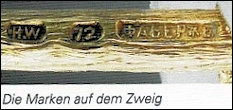 Hallmarks on the Stem (Hampel Auction)
Hallmarks on the Stem (Hampel Auction)
Problems: Second period missing on the H.W. mark. Assay mark only gives the gold value, is missing the city
with assayer’s initials. Are hawthorn stems ribbed on the other Fabergé hawthorns or in nature?
Known Henrik Wigström Marks
(Courtesy Ulla Tillander-Godenhielm)
- Dorotheum, Vienna, May 29, 2018, Lot 346, estimate of EUR 80,000 to 120,000 (US$ 94,500 to 141,500). Did not sell. The auction catalog description:
“FABERGÉ – Hawthorn, agate, jasper, nephrite, jade, gold, hawthorn with gold stem, ripe berries of red jasper, unripe berries of white jasper, nephrite leaves, planted in imitation gold soil, vase of white agate on a jade base, height: 13,5 cm, maker’s mark H. W [
sic] (more correctly H.W.

) = Henrik Wigström, company mark “FABERGÉ”, purity mark “72”, in birch wood case of “A La Vieille Russie 785 Fifth Avenue New York”. Excellent workmanship by the renowned Fabergé master craftsman Henrik Wigström. Comparable item to Sotheby’s New York December 11 and 12, 1985 cat. 117 (Ed. note: Hawthorn from Yznaga/Woolf collections) and also an item in
Fabergé-Cartier, Rivalen am Zarenhof, edited by Géza von Habsburg, Munich 2003, cat. no. 388. (Ed. note: Gray Collection hawthorn).”
From this brief study a number of questions remain for Fabergé researchers to pursue.
- Which of these hawthorn studies are from the Wigström atelier (active 1903-1917)?
- What stylistic differences are visible?
- What published literature and archival resources are helpful in conducting further research on flowers originally owned by members of the Russian imperial court or their relatives? The British Royal Collection has flowers with original provenances.
Publications recommended:
Swezey, Marilyn Pfeifer, et al., Fabergé Flowers, 2004 (page 26 shows a red currant in a vase, unmarked, State Hermitage Museum, St. Petersburg; page 88, a rowan tree is illustrated. Two extant design sketches of flowers from the Wigström studio appear on pp. 62, 64)
Auction catalogs showing lots sold by the two leading auction house, Christie’s and Sotheby’s.
Exhibition catalogs and Fabergé books annotated on the Fabergé Research Site.
Archival records to consult include the Fabergé London Branch Sales Ledgers, and purchases made by the Imperial family in Guzanov, A. and R.R. Gafifulin, Fabergé Items of Late XIX–Early XX Century in the Collection of the State Museum of Pavlovsk, 2014.
Eggs
Remembering a Special Exhibition
Fabergé: The Imperial Eggs, October 22, 1989 – January 7, 1990
The Mieks Fabergé Eggs
website maintained for many years by Annemiek Wintraeken contains detailed histories and events relating to Fabergé Easter eggs. A recent addition to the listing of early exhibitions (1900, 1902 and 1939) is an illustrated essay of the 1989
Fabergé Venue in San Diego at which 27 Fabergé Eggs were reunited for the first and probably the only time ever. For the contributors to her essay it was a walk down memory-lane as they reminisced about this unbelievable Fabergé exhibition taking place 30 years ago.
1902 Clover Leaf Egg Surprise Identified? A Team Effort
In this essay, two Fabergé enthusiasts provide tantalizing information about this surprise.
Annemiek Wintraecken (The Netherlands) writes:
In October 2017, Fabergé egg enthusiast Greg Daubney from the United Kingdom sent me a photograph of Empress Alexandra Feodorovna wearing a medallion around her neck. He suggested it might be the missing surprise (later identified with a portrait of the Tsesarevich Alexis) for the 1907 Rose Trellis Egg. While studying this image, I noticed the Empress was also wearing a brooch or pin resembling a four-leaf clover on her waist cummerbund. Could it be the missing surprise for another egg, the 1902 Clover Leaf Egg by Fabergé? How many four-leaf clover jewels with four tiny portraits could the Empress have owned? Unfortunately, the enlarged image was unclear and too vague to determine if the jewel was by Fabergé, but the more I looked at the object, the more I realized there were at least four miniature portraits on clover leaves bordered by diamonds. And with a little bit of imagination one can even see the faces of the four daughters of the Imperial couple, Emperor Nicholas II and his wife, Alexandra Feodorovna.
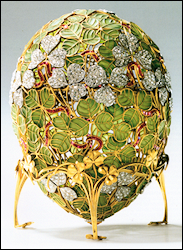 1902 Clover Leaf Egg
1902 Clover Leaf Egg
(Muntian, Tatiana, Fabergé.
Easter Gifts, 2003, 36-39)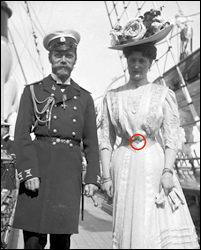 Nicholas II and Alexandra on Board
Nicholas II and Alexandra on Board
the Imperial Yacht Standart at Reval,
Russia (now Tallinn, Estonia) in
June 1908.
Juan F. Déniz (Gran Canaria, Canary Islands) writes:
In June 2018, I found an illustration of a clover leaf in an article entitled “Unscrambled Eggs” by Geoffrey Munn1 with this caption: “An undated design for a jewel in the form of a four-leaf clover set with diamonds. Each leaf has an open aperture, probably for miniatures or photographs. From the Holmström Archive. Wartski, London.” I recalled Annemiek Wintraecken’s research on the 1902 Clover Leaf Egg and her hypothesis about the missing surprise, both discussed on her website.
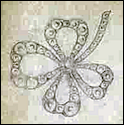 Holmström Design Sketch
Holmström Design Sketch
(Courtesy of Geoffrey
Munn, Wartski, London)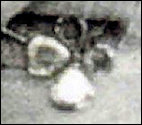 Enlargement of Quatrefoil
Enlargement of Quatrefoil
Worn by Empress Alexandra
on Her Cummerbund
(Courtesy Royal Collection)
I was not certain the ornament was created by Fabergé, since brooches or similar jewels in the form of a clover were a fashionable accessory for women during Fabergé’s time. After lining up the design sketch next to the enlarged brooch or pin in the shape of a clover leaf worn by the Empress in 1908, the similarity became apparent based on the different sizes of the leaves and their shapes. Is Holmström’s design sketch the prototype for Alexandra’s accessory?
Tatiana Muntian in her essay in the exhibition catalog for the first major Fabergé exhibition in the former Soviet Union in 19893 states:
“The ‘surprise’ of the Clover Egg from the Kremlin is lost but some archive papers make it clear that there was a large ‘clover leaf of four foils with 23 diamonds, roses and four miniature portraits.’ One may only guess that the portraits were those of [the] Tsar’s daughters. …” Muntian concludes with an explanation of the symbolic meaning of the four-leaf clover or quatrefoil.
The 1902 Egg is included without its surprise in the detailed 1909 inventory of the Imperial family’s private apartments by Nikolai Dementiev, inspector of the premises of the Winter Palace. Was the surprise “in use” by the Empress as a piece of jewelry to be worn? The Clover Egg with its stand is just 3 7/8 in. (9.8 cm) in height, so its surprise had to be quite small. Illustrated below are the prongs for the surprise:
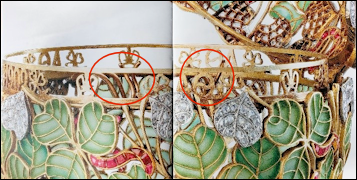 Close-up of the Egg and Prongs, Possibly a Jeweler’s Technique to
Close-up of the Egg and Prongs, Possibly a Jeweler’s Technique to
Secure the Top and Bottom of the Delicate Egg or to Hold the Lining for
the Surprise2 (Photograph from Muntian, Tatiana, Фаберже.
пасхальные подарки [Fabergé. Easter Gifts, also an English
Edition], 2018, 103-105)
 Enlargement with the Prongs (Colorized by Ben Swindle)
Enlargement with the Prongs (Colorized by Ben Swindle)
The authors contacted Geoffrey Munn, managing director emeritus, Wartski, London, with their hypothesis. His response was as follows:
“As I said in the article the quatrefoil is, for obvious reasons, a very popular device in 19th and early 20th century. It not only stands for luck in love, but is well established in Christian lore. However, since the surprise is missing and there is a quatrefoil worn by the Empress there is every reason to think this is the very one. Bravo for the discovery to both Juan and you!”
An effort to find the surprise pictured in auction catalogs from 1934 to the present has not yielded any results. A
quatrefoil dated 1890, without spaces for photographs and yet similar to the Holmström design sketch was made in the Mikhail Perkhin workshop. It sold at auction, Christie’s London, November 26, 2018, Lot 208.
ENDNOTES:
1 Antique Collecting, June 2015, 40-45.
2 Explanatory text courtesy of Timothy Adams. The Rose Trellis Egg is shown open with its lining in Tillander-Godenhielm, Ulla, Fabergé, His Masters and Artisans, 2018, 132, and on the Mieks Fabergé Eggs website.
3 Muntian, Tatiana, “New Information of the Fabergé Pieces in the Kremlin Collection” in The Fabulous Epoch of Fabergé, 1992, p. 71. The exhibition opened on February 8, 1989, but the catalog did not appear until 1992. (McCanless, Christel Ludewig, Fabergé and His Works: An Annotated Bibliography of the First Century of His Art, 1994, # 1520)
Museum News
Virginia Museum of Fine Art
Newsletter contributors Annemiek Wintraecken and Daniel Briére each found a link to a 105-year-old photograph showing the Fabergé sailor that has been in the Pratt Collection at the Richmond, Virginia, museum since 1947. The find is courtesy of an online blog (Winter Palace Research by Joanna Wrangham November 11, 2008).
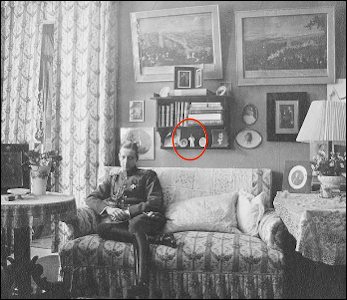 Grand Duke Dmitri Pavlovich Is Seated on the Couch.
Grand Duke Dmitri Pavlovich Is Seated on the Couch.
(Winter Palace Research Blog, November 11, 2018).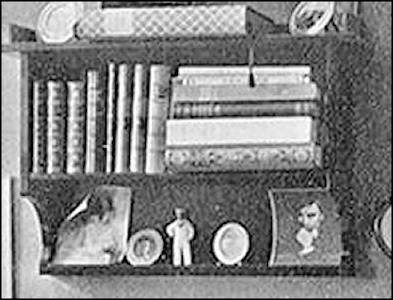 Sailor Figurine Spotted in a Book Case in the Home of Grand Duke
Sailor Figurine Spotted in a Book Case in the Home of Grand Duke
Mikhail Mikhailovich and His Morganatic Wife Natasha, Gatchina
Palace, see correction below).
Annemiek Wintraecken writes, “It is a nice addition to our story ‘The Zarnitsa Sailor and His Place in History’ published by the Virginia Museum of Fine Arts in their 2011
Fabergé Revealed book, pages 102-109.”
Daniel Briere adds that the location of the house identified above was “not at the Gatchina Palace but at the house Grand Duke Mikhail bought in 1914 when he came back from exile. It was located at 24 Nikolaevskaya St., now Uritskogo St. (one mile east from the Gatchina Palace).” On her blog, Joanna Wrangham does identify the photographs as being from “Grand Duke Mikhail’s House in Gatchina”; her mention of the Palace only applies to the last of 6 photographs she posted. I found no date for the sailor photograph but it cannot be before autumn 1914 when Grand Duke Dmitry was awarded his St. George Cross (4th class) on October 13, 1914.
McFerrin Collection at the Houston Museum of Fine Arts in Texas
Fabergé Imperial Presentation Boxes for 1884, 1894, and 1902, Workmaster Mikhail Perkhin
(Courtesy McFerrin Collection)
Readers are invited to a Fabergé Happening at the Houston Museum of Natural Science on
April 15, 2019. If you have not seen the new Artie and Dorothy McFerrin Gallery showcasing the Fabergé and Russian decorative arts collection, now connected to the amazing Cullen Hall of Gems and Minerals, you are in for a treat!
Timothy Adams, art historian and a frequent contributor to the Fabergé Research Newsletter, is presenting the guest lecture, Fabergé Imperial Gifts: Private and Official. An exhibition booklet, Fabergé – The McFerrin Collection: The Art of Presentation, has been prepared by the McFerrin Foundation to coincide with this event, with essays by Mark Moehrke, Fabergé scholar, and a foreword by Ulla Tillander-Godenhielm, Fabergé scholar and author of the book, The Russian Imperial Award System, 2005. (The publication for this special exhibition will only be available on-site.)
Event details ….more
Publications
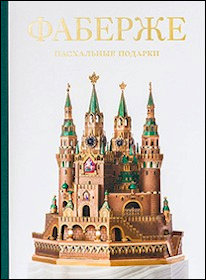 Muntian, Tatiana, Fabergé.
Muntian, Tatiana, Fabergé.
Easter Gifts, 2018 de Guitaut, Caroline, and Stephen Patterson,
de Guitaut, Caroline, and Stephen Patterson,
Russia, Royalty & the Romanovs, 2018
Books
An archival resource, Catalogue of the Exhibition of Russian Art: 1 Belgrave Square, London S.W. 1, 4th June to 13th July, 1935, is now online. (Our thanks to Louis Adrean, senior librarian, Ingalls Library, Cleveland Museum of Art, for making this happen.)
von Solodkoff, Alexander, The Jewel Album of Tsar Nicholas II and a Collection of Private Photographs of the Russian Imperial Family, 1997.
The book, containing watercolors of his private collection drawn by Nicholas II, is summarized and illustrated in an article by Paul Gilbert, editor of the Royal Russia News.
Fabergé: Precious Jewellery of the Russian Empire, catalog for an exhibition at the National Museum, New Delhi (May 2008-January 2009), curated by Tatiana Muntian, Moscow Kremlin Museums, 2008.
For the first time, Fabergé collections from Moscow and St. Petersburg traveled to India, a country traditionally celebrated for its skilled jewelers and jewelry collections.
Muntian, Tatiana, Fabergé. Easter Gifts, 2018.
An over-sized book with new illustrations and archival photographs updates a smaller book published by Muntian in 2003. The world’s largest collection of imperial Easter eggs created by the firm of Carl Fabergé is in the Museums of the Moscow Kremlin. These eggs are connected with the history of Russia and the life of the imperial family at a turning point in the fate of a huge power. Further details, complete with illustrations, are found in an article, “Kremlin Releases New Book” in Royal Russia News, October 2018. Newsletter reader Simon Frame from Australia alerted me to this stunning new book by Tatiana Muntian. Cathy Roach from Texas han-carried a Russian edition from Moscow to the USA (now my proud possession-newsletter readers are the best!). Since then an English-language edition has been published. Please note: In Russia, his book is generally only available in museum stores in the Alexander Garden and opposite the Patriarch’s Palace, as well as at the Armory and in the Annunciation and Assumption cathedrals in Moscow. Bronze Horseman Books will assist with English editions. (At press time, Ulla Tillander-Godenhielm advised both the Russian and English editions are available in the museum shop of the Fabergé Museum in St. Petersburg.)
de Guitaut, Caroline, and Stephen Patterson, Russia, Royalty & the Romanovs, 2018.
In an extensive monograph published to coincide with the exhibition (November 9, 2018 – April 28, 2019, Queen’s Gallery, London, Russia, Royalty & the Romanovs), the authors examine the relationship between Britain and Russia through the lens of art in the Royal Collection. Fabergé objects are interspersed in the familial, political, diplomatic, and artistic stories of the two countries and their royal families over more than 400 years. (Thank you John Jenkins for sending me this amazing book.)
The Fabergé Museum in St. Petersburg, Russia, began sponsoring annual symposiums in 2014. The summaries of the research presentations are published a year after the event. The September 2017 symposium booklet is entitled Russian Jewellery Art of the 19th and Early 20th Centuries in a Global Context, 2018.
Fabergé Easter Masterpieces from the Collection of Fabergé Museum in St. Petersburg, 2018, is a reprint of the first edition and authored by Tatiana Muntian, originally published in 2014. This fourth reprint features the museum’s ten Fabergé Easter eggs on a black background.
Dealers: Catalogs and News
Since 1995, A La Vieille Russie (ALVR) in New York City has been publishing a holiday catalog with Fabergé objects included. The 2018 edition is available in both hard copy and online. Readers who have duplicate copies to share, please contact: christel@fabergeresearch.com Recent articles introduce the reader to ALVR’s new location on Fifth Avenue and an article, Q&A: Mark Schaffer, a principal in the family business (Antiques and The Arts Weekly, June 12, 2018).
A selection of news from Wartski, a London Fabergé dealer also in a new location:
Journals and Newspapers
Ulla Tillander-Godenhielm, author of the recent book Fabergé: His Masters and Artisans, and Geoffrey Munn, formerly of Wartski London, were interviewed by CNN, an American television network. Tillander-Godenhielm describes her “unconventional approach to the jewelry house’s oeuvre by focusing on the collaborators that Fabergé surrounded himself with, from designers to the master gold- and silversmiths who helped bring their visions to life.” The online version of the interview House of Fabergé: The Story behind the World’s Most Luxurious Eggs, with a plethora of Fabergé eggs as illustrations, was published in August 2018.
For the September 2018 issue of the Finnish journal, Antiikki & Design, Tillander-Godenhielm was asked to write her story, Minä ja Fabergé (Me and Fabergé). Fortunately for Fabergé Research Newsletter readers, she agreed to tell her story in English, which follows!
My journal article is a mini-autobiography. I have collaborated with the
Journal Antiques & Design since it was started 25 years ago by writing articles on the history of jewelry, Fabergé, and in a column answering readers’ questions about jewelry. The journal’s editor-in-chief asked members of his team to write something about their lives. For me the challenge was to explain how I got into the jewelry business and how I learned about Fabergé.
So in short: For a child born back in those days into our family, it was clear already in the cradle that I had to follow in my father’s footsteps. My dad, Herbert Tillander, was the third generation of our family firm which was founded in 1860 by his grandfather Alexander Tillander in St. Petersburg, Russia. I have the funny story of how I was first acquainted with precious stones in the Foreword of my book, Jewels from Imperial St. Petersburg (page 9): snatching my dad’s rubies, emeralds and sapphires from his desk, thinking they were candies. So that is why I have the snapshot of one-year old Ulla on the potty, waiting for the precious gems to re-appear. The next photograp in the family album is of a 17-year-old in the school photo-exchange student year in the USA-a great experience during my high school years.
I never would have been a good craftsman making jewelry myself or for that matter be a designer. Instead I learned the trade by studying business (BA in Economics), after which I was sent ‘out in the world’ by my father. While in the United States during my last year in high school, I attended a diamond grading course at the Gemological Institute of America in Los Angeles. Next my training and experience included four years in London-first with a diamond dealer in Hatton Garden where I learned to grade diamonds. Then a stint with an Antwerp diamond cutting company, Komkommer & Cie, acting as their ‘salesman’ of diamonds in the UK and Ireland (my best customers were Dublin jewelers). I was also purchasing precious stones and antique jewelry for our firm back home and sold our own Finnish designed jewelry in London. All of this without much financial success for the family firm in Helsinki. But it was excellent experience for my future job! When I reminisce, I do not understand how a father could think a young girl without any experience could succeed in that world. But it was a great learning experience! After returning home I began working in our family business and later managed it.
Fabergé came into the picture when our firm celebrated its 120th anniversary. We decided to arrange the 1980 exhibition called Fabergé and His Contemporaries, which was a tremendous success. My friend and colleague Christina Grönblom (with whom I am visiting in Florida as I write this) knew not a single thing about Fabergé. We contacted Kenneth Snowman, Wartski London, who was exceedingly generous with loans, and Géza von Habsburg, head of Russian works of art with Christie’s auction house. We received major objects from Wartski, Christie’s, Bolin in Stockholm, many loans and great assistance from all the descendants of the former masters of Fabergé as well as descendants of the customers of Fabergé-Nobel, Gilse van der Pals, Neuscheller, etc. The Bismarck box was on its way to our exhibition and today (40 years later)- it is on view at the Houston Museum of Natural Science not far from Christina and I are at present.
The 1980 exhibition was my first encounter with object d’art from the Russian court jeweler Fabergé and it gradually resulted in my published books and the exhibitions held all over the world to which we were able contribute exciting loans from Finland. I decided to go back to the university for further studies on the history of art- finally specializing in the arts of the St. Petersburg jewelers and receiving my Ph.D.
It has been a fantastic journey and especially remembering all the amazing people I have had the chance to meet. How they all have helped me during my life’s journey really overwhelms me!
Erik Schoonhoven (Independent Jewellery Historian, The Netherlands) published an article,
A Closer Look at the 1901 Queen Wilhelmina Nephrite Tray Last Seen in 1980 in the
Fabergé Research Newsletter,
Summer 2018. The Dutch paper of record,
NRC Handelsblad in its January 17, 2019 edition, used a full-page illustration of the Fabergé Queen Wilhelmina tray on the
front page of its
Cultural Supplement.
Gerlis, Melanie, “Art Business-Auction Catalogues,” Apollo, December 2018, p. 102. “Have printed auction catalogues had their day? As art businesses branch out into other types of content-from in-house magazines to video-and audiences become ever more impatient, this traditional format may soon be obsolete. But at what cost?” More…
Online Research Tools
The Alexander Palace Time Machine Discussion Forum posted on its website a List of Imperial Jewels Found in Tobolsk 1933, “a small but critical fraction of the possessions of the Russian Imperial family in exile. The true story was well hidden, until the fall of Communism in Russia, and [the list was] published in 1996. Our thanks to Rob Moshein for transcribing the list as printed in ‘The Last Act of a Tragedy’ by V.V. Aleskeyev, Yekaterinburg, 1996.”
PALA International located in Fallbrook, California, has been in the international gemstone business since 1969. A lengthy article by David Hughes, Avarice and Alienation: Jewels of the Romanoffs begins with first five years following the removal of the Romanovs, 1917-1922, and in part 3 ends with a summary for the years 1976-1997. Readers of the Fabergé Research Newsletter who read the series of articles on the Fersman Portfolio (Fall 10 | Winter 10-11 | Spring 12 | Spring 13 | Winter 15 | Summer and Fall 16) may find this newspaper study of the Romanovs jewels and their travels interesting.
Unusual publications: A work of fiction, a children’s book, and a coloring book for grown-ups with patience and imagination in using colored pencils will teach a lot about the Romanovs.
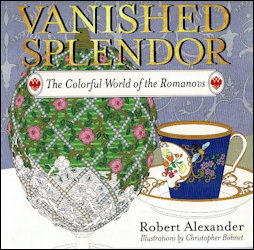 Alexander, Robert et al. Vanished Splendor: The
Alexander, Robert et al. Vanished Splendor: The
Colorful World of the Romanovs, 2017
(Courtesy of the Author)
Sophie Law, in her interview with RussianArt+Culture, October 25, 2018, discusses “the mystery of Fabergé eggs and legacy of the Romanovs today,” which serves as the plot of her novel published in 2018.
Solomadina, Natalia, How Did He Dream that Up? Fabergé’s Creations (Соломадина, H. Что придумал Фаберже), 2016. Book in two editions, in Russian and in English.
This author introduces her book in Russian. The third in a series of books intended to introduce school children to the world’s renowned innovators, the Carl Fabergé biography highlights well-known goldsmiths’ objects created by the Russian jewelry firm for the Imperial Court, as well as for the high society of that time. Heavily illustrated with a combination of archival and modern photographs, the book also appeals to adults. Sample pages from the book and, in particular, a unique view of the undercarriage of the Coronation Egg, are shown by the owner of a website.
Alexander, Robert with Christopher Bohnet (Illustrator), Vanished Splendor: The Colorful World of the Romanovs, 2017.
“Drawing from decades of work, travel, and research in Russia, the author has created a stunning coloring book with every detail rooted in the rich, colorful history that was the glory of Imperial Russia.” Alexander depicts in some detail the grand world of the Nicholas and Alexandra Romanov, and three Fabergé eggs await adult color-pencil artists and Fabergé enthusiasts.
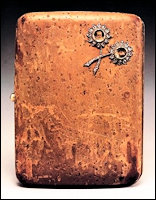
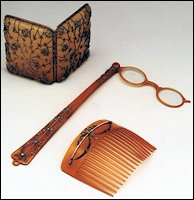
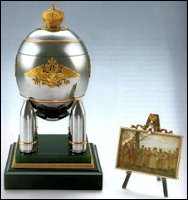

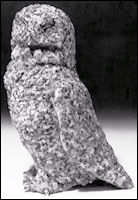
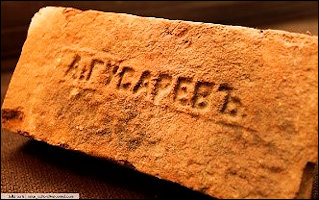
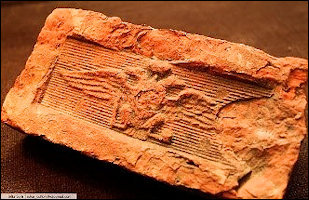
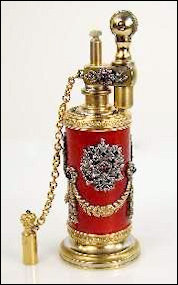
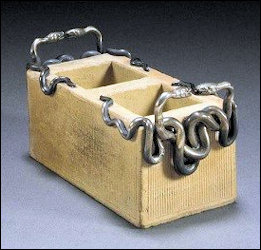
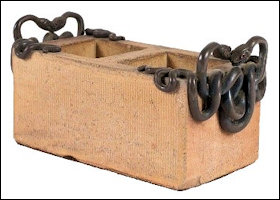

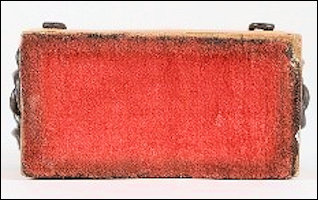

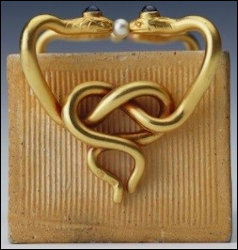

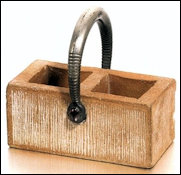
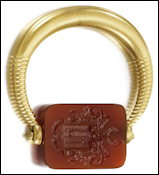
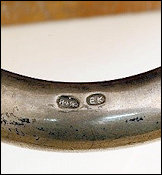
![]() as his mark. Ulla Tillander-Godenhielm, who has studied the Fabergé workmasters for many years, clarified the use of the I.P. mark to the authors:
as his mark. Ulla Tillander-Godenhielm, who has studied the Fabergé workmasters for many years, clarified the use of the I.P. mark to the authors: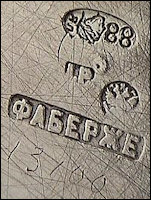

 . Lasting only a few years, its place in the Fabergé firm was taken over by the Armfelt workshop.
. Lasting only a few years, its place in the Fabergé firm was taken over by the Armfelt workshop.